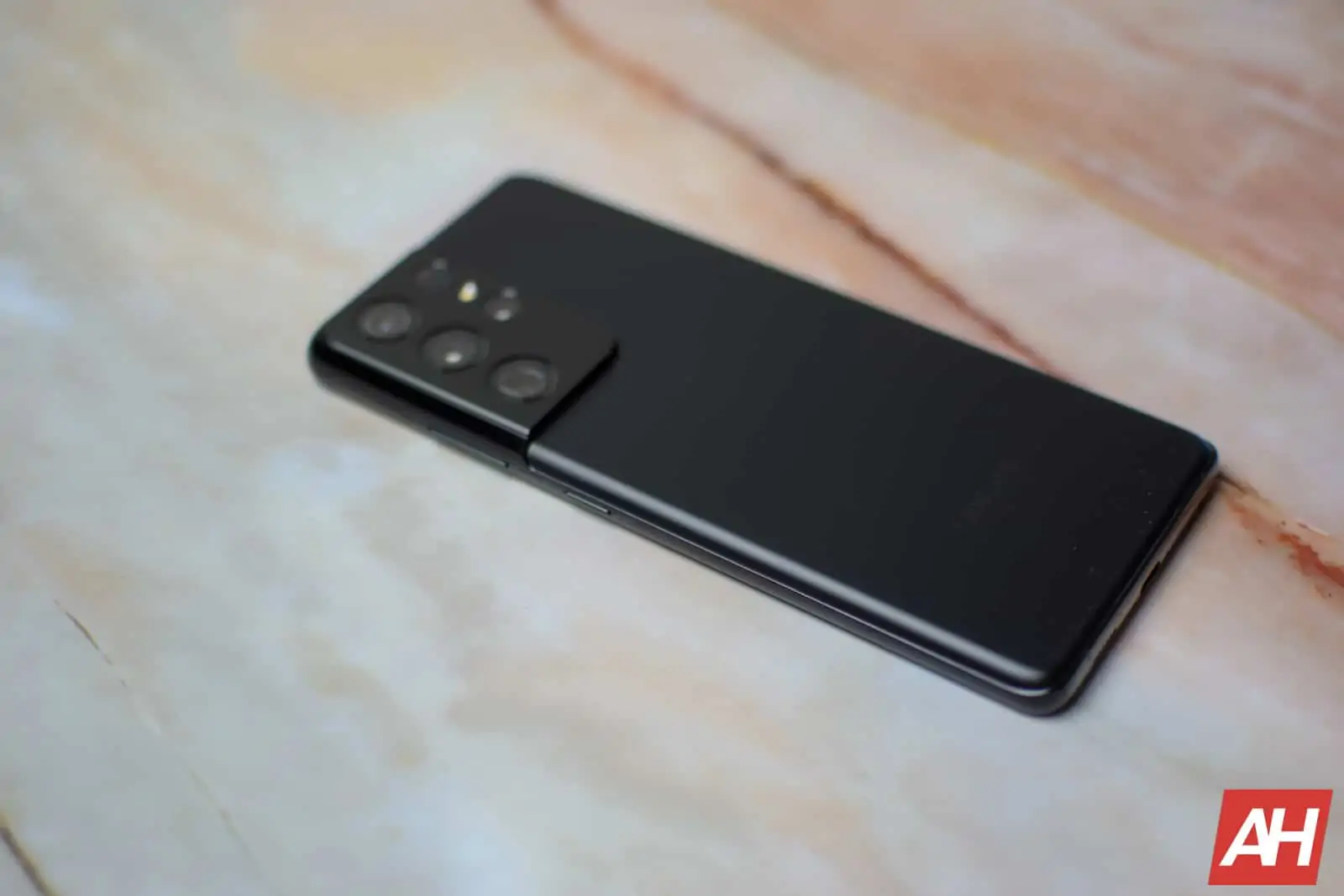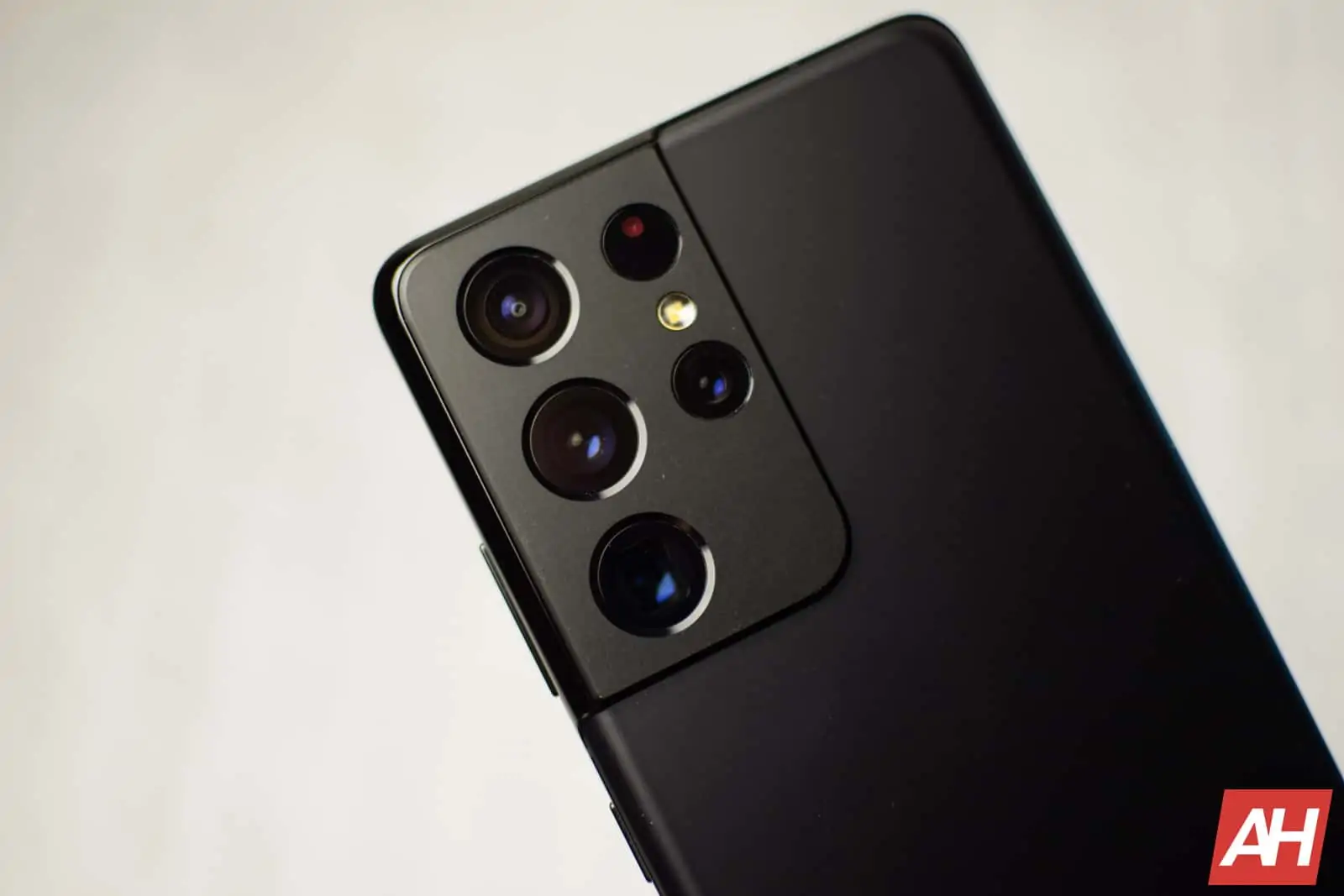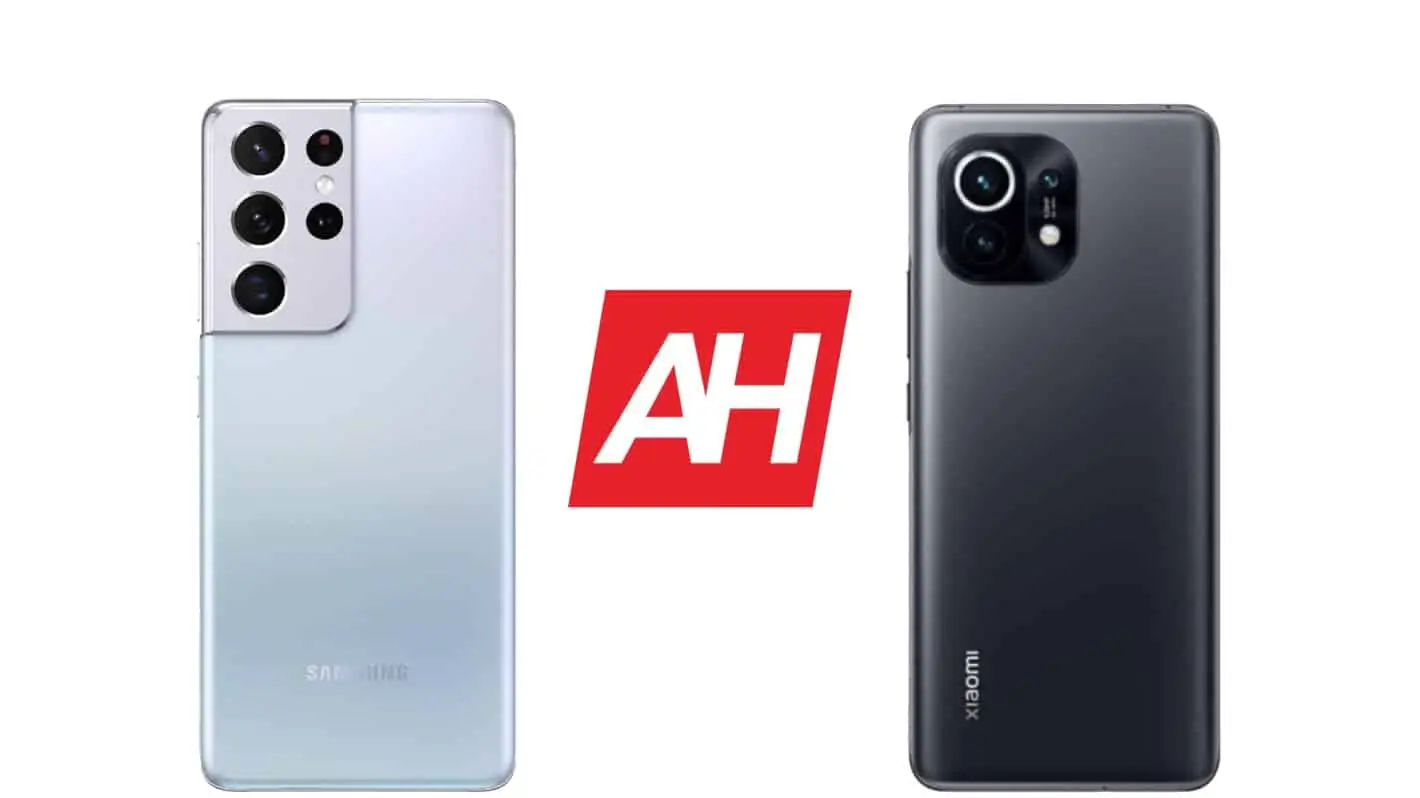We’re here to compare the Samsung Galaxy S21 Ultra vs Xiaomi Mi 11. These two smartphones are the best Samsung and Xiaomi have to offer at the time of writing this article. It is worth saying that the Xiaomi Mi 11 is much more affordable than the Galaxy S21 Ultra. You can almost buy two Mi 11 units for the price of one Galaxy S21 Ultra. Both of these phones are flagship-grade offerings for their respective companies, therefore, comparing them makes sense.
The Galaxy S21 Ultra and Xiaomi Mi 11 don’t have all that much in common, to be quite honest. Some of their specs are the same, but for the most part, they’re as different as they can be. As per usual, we’ll compare the two phones across a number of categories. We’ll first list their specifications, and then move to compare the designs, what they have to offer in terms of displays, performance, battery performance, and so on.
Specs
| Samsung Galaxy S21 Ultra | Xiaomi Mi 11 | |
| Screen size | 6.8-inch WQHD+ Dynamic AMOLED 2X display (120Hz adaptive refresh rate) | 6.81-inch WQHD+ AMOLED quad-curve DotDisplay (120Hz) |
| Screen resolution | 3200 x 1440 | 3200 x 1440 |
| SoC | Qualcomm Snapdragon 888 / Samsung Exynos 2100 | Qualcomm Snapdragon 888 |
| RAM | 12GB/16GB (LPDDR5) | 8GB (LPDDR5) |
| Storage | 128GB/256GB, non-expandable (expandable in some countries) | 128GB/256GB (UFS 3.1); Non-Expandable |
| Rear cameras | 108MP (f/1.8 aperture, OIS, 0.8um pixel size. Produces 12MP images with 2.4um pixel size) 12MP (ultrawide, Dual Pixel AF, 120-degree FoV, f/2.2 aperture, 1.4um pixel size) 10MP (telephoto, Dual Pixel AF, OIS, f/2.4 aperture, 1.22um pixel size, optical zoom 3x) 10MP (telephoto, Dual Pixel AF, OIS, f/4.9 aperture, 1.22um pixel size, 10x optical zoom, 100x Space Zoom) |
108MP (f/1.85 aperture, 7P lens, OIS, 1/33-inch sensor size, 0.8um pixel size, 1.6um 4-in-1 Super Pixel) 13MP (f/2.4 aperture, 123-degree FoV) 5MP (telemacro, f/2.4 aperture, AF 3cm-10cm) |
| Front cameras | 40MP (f/2.2 aperture, 80-degree FoV, 0.7um pixel size, PDAF) | 20MP (0.8um pixel size, 1.6um 4-in-1 Super Pixel, f/2.2 aperture) |
| Battery | 5,000mAh, non-removable, fast battery charging (USB PD 3.0), Fast Wireless Charging 2.0, Wireless PowerShare | 4,600mAh, Non-Removable, 55W fast wired charging, 50W fast wireless charging, 10W reverse wireless charging |
| Dimensions | 165 x 75.6 x 8.9 mm | 164.3 x 74.6 x 8.06mm |
| Weight | 229 grams | 196 grams |
| Connectivity | 5G, LTE, NFC, Bluetooth 5.2, Wi-Fi, USB Type-C | 5G, LTE, NFC, Bluetooth 5.2, Wi-Fi, USB Type-C |
| Security | In-display fingerprint scanner (ultrasonic) | In-display fingerprint scanner (optical) |
| OS | Android 11 One UI 3.0 |
Android 11 MIUI 12.5 |
| Price | $1,199.99 | €799 |
| Buy | Samsung | Xiaomi / AliExpress |
Samsung Galaxy S21 Ultra vs Xiaomi Mi 11: Design
Both of these phones are made out of metal and glass, both of them are huge, and also quite slippery. You’ll notice curved displays on both smartphones, though the curvature is quite different. The Galaxy S21 Ultra’s display is curved on the sides, and also a bit less than the Mi 11. The Xiaomi Mi 11 has a quad-curved display, on all of its sides. The Galaxy S21 Ultra includes a centered display camera hole, while the Xiaomi Mi 11’s is placed in the top-left corner of the display.

Bezels are extremely thin on both smartphones, almost non-existent. Physical buttons sit in almost the same spots, they’re located on the right-hand side. The power / lock button is placed below the volume rocker buttons on both devices. Company brandings are located on the back, while both utilize a Type-C USB port at the bottom. The back sides of both phones are curved as well, though the two phones feel entirely different in the hand.
The Galaxy S21 Ultra features a huge camera housing on the back, which is an extension of its frame. It offers a metal shell. The Xiaomi Mi 11 offers a more regular camera housing on the back, though it looks different from anything else on the market. The Galaxy S21 Ultra’s camera setup protrudes on the back more, that’s for sure. The Galaxy S21 Ultra is slightly higher, wider, and thicker than the Mi 11. It’s also noticeably heavier, around 30 grams heavier. Both feel premium in the hand, and you can’t go wrong when it comes to the design, the question is which one you like more.
Samsung Galaxy S21 Ultra vs Xiaomi Mi 11: Display
Both of these phones offer gorgeous displays, there’s no doubt about it. The Samsung Galaxy S21 Ultra features a 6.8-inch WQHD+ (3200 x 1440) Dynamic AMOLED 2X panel. That is a curved display, with an adaptive refresh rate of up to 120Hz. It supports HDR10+ content, and it’s protected by the Gorilla Glass Victus. This display gets really bright as well, it can go up to 1,500 nits.
The Xiaomi Mi 11 is not far from this setup, actually. It features a 6.81-inch WQHD (3200 x 1440) AMOLED display which supports HDR10+ content as well. This display also offers an adaptive refresh rate of up to 120Hz, and it’s protected by the same Gorilla Glass version from Corning as the Galaxy S21 Ultra. When it comes to brightness, it gets just as bright as the panel used in the Galaxy S21 Ultra.
In real life, these two displays look amazing, to say the least. They’re incredibly sharp, get really bright, and the colors are extremely vivid. These two panels are amongst the best in the market, without a doubt, if not the best ones. You’ll enjoy using them every step of the way, and that high refresh rate only emphasizes their quality. The blacks are also quite deep, as they should be on AMOLED panels. The viewing angles are excellent. There’s really not much to complain about here, if anything.
Samsung Galaxy S21 Ultra vs Xiaomi Mi 11: Performance
You’d expect top notch performance out of flagship smartphones from these two companies, and that’s exactly what you’re getting here. There’s really nothing to complain about when it comes to performance. The Snapdragon 888 is paired with really powerful internals in both smartphones, and their software offerings are well-optimized. These two handsets can fly through anything you throw at them.
In regular, day-to-day usage, they’ll perform without a stutter. No matter if you’re browsing the web, taking pictures, consuming multimedia, or doing something else entirely. If gaming is your thing, both phones will deliver as well. They can run basically any game in the Play Store on the highest of settings without an issue, unless the game itself has issues, of course. These two handsets are excellent phones for gaming, though, that’s for sure.
They do offer considerably different software offerings, as One UI and MIUI are quite different at this point in time. Both are excellent, though, and offer tons of features. The only question is, which do you prefer, as chances are you have a preference in this matter. Regardless, both smartphones will offer great performance.
Samsung Galaxy S21 Ultra vs Xiaomi Mi 11: Battery
Both devices have large battery packs. The Galaxy S21 Ultra comes with a 5,000mAh battery, while the Mi 11 offers a 4,600mAh battery on the inside. Is there any difference when it comes to battery longevity, though? Well, it all depends on your usage, of course. Your mileage will, of course, be different than ours, and so on. The point is, both of these phones should provide you with more than enough battery during the day.
Both devices can easily cross the 6-hour screen-on-time mark, unless you’re pushing that SoC extra hard with gaming or something of the sort. The Galaxy S21 Ultra will likely offer you a bit more juice, though, as it crossed the 7-hour mark for us quite comfortably. Both phones offer excellent battery life, just keep in mind the Galaxy S21 Ultra will probably last a bit longer. Both will be enough for pretty much everyone in terms of battery, though.
What about the charging? Well, this is where the Xiaomi Mi 11 has an advantage, as it offers faster charging all around. The Xiaomi Mi 11 offers 55W fast wired charging, and 50W fast wireless charging. On top of that, you’re getting 10W reverse wireless charging. The Galaxy S21 Ultra, on the other hand, offer 25W fast wired charging, 15W wireless charging, and 5W reverse wireless charging.
Samsung Galaxy S21 Ultra vs Xiaomi Mi 11: Cameras
Are the cameras any good? Well, the short answer is… yes! Both of these smartphones have quite capable cameras, though they are different in their performance. The Galaxy S21 Ultra also has one more camera on the back than the Mi 11. Both include 108-megapixel main cameras, though those are not the same sensor. Both phones tend to saturate images a bit, but they don’t overdo it, at least in most situations. Daylight images turn out extremely sharp, and well-balanced.

In low light, both phones do a great job as well. The Galaxy S21 Ultra does retain a bit more details, but both phones tend to do a great job, and light up the scene more than enough. Ultra-wide cameras do a good job in all lighting conditions, though the Galaxy S21 Ultra’s is better in low light. The Galaxy S21 Ultra also comes with two telephoto lenses, one of which is a periscope one.
The Xiaomi Mi 11 does not have a periscope lens, or a telephoto lens in general. The Galaxy S21 Ultra can utilize camera zoom up to 120x, though you probably don’t want to go beyond 30x. Selfie cameras are good, there’s not much to say here. They do a really good job, even compared to direct competition.
Audio
Both phones are equipped with stereo speakers, and the speakers on both phones are excellent. The Galaxy S21 Ultra audio is tuned by AKG. The Xiaomi Mi 11, on the other hand, comes with speakers tuned by Harman Kardon. The sound that those speakers can provide is excellent for smartphones. It’s rich, loud, well-balanced, and it doesn’t get distorted when you crank up the volume.
When it comes to sound via headphones, well, first and foremost, there is no 3.5mm headphone jack here, on either phone. You can plug in your headphones via the Type-C port, or utilize Bluetooth. When you do, you will get a pleasant sound as a reward. Neither of the two phones are out of this world when it comes to sound, but they’re excellent nonetheless. They’ll satisfy the vast majority of people when it comes to audio.

